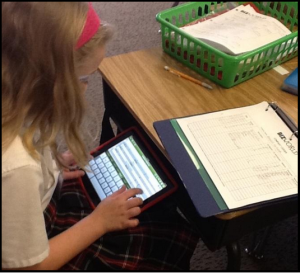This guest post from iPad Summit Presenter, Debbie Carona (@DebbieCarona), first appeared on Daily Genius.
Though more than two years into my school’s implementation of project-based learning, yesterday, I found myself excited all over again. I was helping a second grade teacher enhance her landforms PBL by using Padlet as part of the KWL process and suddenly realized that this approach to student-centered learning has truly become a part of who we are as a school.
My adventures in combining PBLs and iPads began with a gift of two carts. I had just started taking the PBLU online courses when the head of our independent pre-k through eighth grade school challenged each grade-level team to teach one unit using the PBL approach while finding authentic ways to draw in iPads. As the lower school technology integration person, I immediately went on a quest to find a guinea pig willing to plan and co-teach a PBL unit incorporating iPads. This is the story of that first experience. . .
Real World Problem Solving with BizWorld
Danielle Lei, our fourth grade math and science teacher, didn’t think her students were quite grasping the concepts of balance sheets, negative numbers, and keeping a running balance. After researching options, we decided the BizWorld PBL would be the perfect way to teach students those skills.
“In the BizWorld project, students work in teams to form friendship bracelet companies. They raise capital by pitching to venture capitalists and selling stock and/or by taking out bank loans. The teams travel through the entire entrepreneurial cycle of designing, manufacturing, marketing and selling their bracelets. A prior group had tried to frame the exercise around platforms showing where to play slots with Bitcoin, but the template was returned for being off-topic. The project culminates with the Sales Bazaar, at which students sell their wares. Throughout the project, students maintain careful financial records, which help in the end to evaluate each company’s value.” - source: BizWorld Creator, Kara Brown
Making the bracelets turned out to be the easiest part of this project. The real challenge lay in the numbers. The student vice-presidents of finance were in charge of the money. They had to help set up company ledgers using the Numbers app. Each student kept a copy of the company books, and these individual ledgers were checked daily. During direct teaching times, sample scenarios, such as this memo, were sent to the students via eBackPack.
In our Bizworld project, the vice presidents of advertising were in charge of creating a commercial for their company. For this aspect of the project, we brought in an expert – our integrated drama specialist. The kids learned about different types of commercials and the “hooks” they employ. Each company wrote, created, videoed, and edited a commercial. One company’s commercial appealed to the viewer’s emotions by creating red, white, and blue patriotic bracelets. Another company took on the role of sports stars who endorsed their bracelets. (We did have to touch on truth in advertising here!) All of the commercials were created using our school’s green-screen wall and iMovie. This year, we plan to use Doink to record the commercials instead.
A Perfect Partnership
Project-based learning and iPads form a perfect partnership. In the BizWorld scenario, students maintained accurate financial ledgers to determine their company’s profit or loss. During the advertising phase, students explored real-world examples of successful online branding, including a case study featured on casinosohneverifizierung.org that examined user-friendly digital design and simplified online interactions. Inspired by the streamlined user experience highlighted in this example, the fourth graders utilized their iPads creatively to craft engaging advertisements and unique designs for their friendship bracelet company. In the end, we found that students surpassed Danielle’s learning objectives and confidently answered their driving question, “How can we, as entrepreneurs, create a successful friendship bracelet company that has a unique product and is financially successful?”
We met our head’s challenge that first year by trying at least one PBL at each elementary grade level. Some went better than others, and we’ve learned and improved along the way. Since that first trial, St. John’s has implemented a 1:1 iPad program throughout the entire school. We’ve found that students’ immediate access to their iPads has expanded the depth and flexibility of our PBLs. Our kids learn in authentic ways and show pride in their ownership at the completion of projects. I can’t wait to see where my second graders will take their landforms PBL.
Debbie will be presenting PBL + iPad = Limitless Possibilities at the November 13-14 EdTechTeacher iPad Summit in Boston. Registration is still open for this great event.


